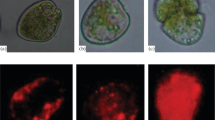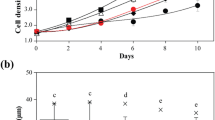Abstract
Biomarkers of temperature stress were studied as major characteristics crucial for the understanding complex processes that underlie the response of marine planktonic microorganisms to environmental factors and their sublethal effects. Using the potentially toxic dinoflagellates Prorocentrum minimum as a model object, the impact of temperature stress on viability, cell cycle, RNA synthesis and DNA replication in these protists was evaluated. It was shown by flow cytometry that stress evoked by a temperature increase from 25°C (control) to 37 or 42°C during 15 to 60 min did not cause any considerable alterations in the cell cycle, while cell death rate increased from ≤ 1% (control) to 2–12% at 37°C and 4–22% at 42°C. Along with a relatively low cell death rate, following a temperature increase to 37 and/or 42°C, P. minimum displayed the ability to boost the synthesis of DNA (1.7–1.9 and 1.2–1.6 times, respectively) and especially RNA (2.5–3.1 and 1.7–2.8 times, respectively) during the first 15–30 min after stress. At certain stages of the life cycle, this effect can be critical for maintaining the viability and normal development of the P. minimum population. The obtained results demonstrate that a significantly elevated synthesis of nucleic acids can serve as an indicator (biomarker) of sublethal environmental stress.
Similar content being viewed by others
References
Okolodkov, Yu.B., Dinoflagellata, Protisty. Rukovodstvo po zoologii (Protists. Handbook for Zoology), 2011, Moscow, pp. 7–94.
Hallegraeff, G.M., A review of harmful algal blooms and their apparent global increase, Phycol., 1993, vol. 32, no. 2, pp. 79–99.
Hackett, J.D., Anderson, D.M., Erdner, D.L., and Bhattacharya, D., Dinoflagellates: a remarkable evolutionary experiment, Am. J. Bot., 2004, vol. 91, pp. 1523–1534.
Telesh, I.V., Schubert, H., and Skarlato, S.O., Ecological niche partitioning of the invasive dinoflagellate Prorocentrum minimum and its native congeners in the Baltic Sea, Harmful Algae, 2016, vol. 59, pp. 100–111.
Skarlato, S.O. and Telesh, I.V., Development of the protistan species-maximum concept for the critical salinity zone, Russ. J. Mar. Biol., 2017, vol. 43, no 1, pp. 1–11.
Orlova, T.Y., Konovalova, G.V., Stonik, I.V., Selina, M.S., Morozova, T.V., and Shevchenko, O.G., Harmful algal blooms on the eastern coast of Russia, PICES Sci. Rep., 2014, vol. 47, pp. 41–58.
Wasmund, N., Göbel, J., and Bodungen, B.V., 100-years-changes in the phytoplankton community of Kiel Bight (Baltic Sea), J. Mar. Syst., 2008, vol. 73, pp. 300–322.
Glibert, P.M., Azanza, R., Burford, M., Furuya, K., Abal, E., et al., Ocean urea fertilization for carbon credits poses high ecological risks, Mar. Pollut. Bull., 2008, vol. 56, pp. 1045–1056.
Olenina, I., Wasmund, N., Hajdu, S., Jurgensone, I., Gromisz, S., Kownacka, J., Toming, K., Vaiciute, D., and Olenin, S., Assessing impacts of invasive phytoplankton: The Baltic Sea case, Mar. Pollut. Bull., 2010, vol. 60, pp. 1691–1700.
Hajdu, S., Edler, L., Olenina, I., and Witek, B., Spreading and establishment of the potentially toxic dinoflagellate Prorocentrum minimum in the Baltic Sea, Int. Rev. Hydrobiol., 2000, vol. 85, pp. 561–575.
Hajdu, S., Pertola, S., and Kuosa, H., Prorocentrum minimum (Dinophyceae) in the Baltic Sea: morphology, occurrence–a review, Harmful Algae, 2005, vol. 4, pp. 471–480.
Grzebyk, D. and Berland, B., Influences of temperature, salinity and irradiance on growth of Prorocentrum minimum (Dinophyceae), Mediter. Sea J. Plankton Res., 1996, vol. 18, pp. 1837–1849.
Pertola, S., Kuosa, H., and Olsonen, R., Is the invasion of Prorocentrum minimum (Dinophyceae) related to the nitrogen enrichment of the Baltic Sea? Harmful Algae, 2005, vol. 4, pp. 481–492.
Werner, I., Stephen, L.C., and Hinton, D.E., Biomarkers aid understanding of aquatic organism responses to environmental stressors, Calif. Agr., 2003, vol. 57, no. 4, pp. 110–115.
Rizzo, P.J., The enigma of the dinoflagellate chromosome, J. Protozool., 1991, vol. 38, pp. 246–252.
Moustafa, A., Evans, A.N., Kulis, D.M., Hackett, J.D., Erdner, D.L., Anderson, D.M., and Bhattacharya, D., Transcriptome profiling of a toxic dinoflagellate reveals a gene-rich protist and a potential impact on gene expression due to bacterial presence, PLoS ONE, vol. 5. https://doi.org/10.1371/journal.pone.0009688
Skarlato, S., Filatova, N., Knyazev, N., Berdieva, M., and Telesh, I., Salinity stress response of the invasive dinoflagellate Prorocentrum minimum, Estuar. Coast. Shelf Sci., 2017. http://dx.doi.org/10.1016/j.ecss.2017.07.007
Spector, D.L., Dinoflagellate nuclei, Dinoflagellates, Spector, D.L., Ed., Orlando, USA, 1984, pp. 107–147.
Hackett, J.D., Scheetz, T.E., Yoon, H.S., Soares, M.B., Bonaldo, M.F., Casavant, T.L., and Bhattacharya, D., Insights into a dinoflagellate genome through expressed sequence tag analysis, BMC Genomics, 2005, vol. 6: e80. https://doi.org/10.1186/1471-2164-6-80.
Lin, S., Genomic understanding of dinoflagellates, Res. Microbiol., 2011, vol. 162, pp. 551–569.
Moreno Diaz de la Espina, S., Alverca, E., Cuadrado, A., and Franca, S., Organization of the genome and gene expression in a nuclear environment lacking histones and nucleosomes: the amazing dinoflagellates, Eur. J. Cell. Biol., 2005, vol. 84, pp. 137–149.
Okamoto, O.K., Robertson, D.L., Fagan, T.F., Hastings, J.W., and Colepicolo, P., Different regulatory mechanisms modulate the expression of a dinoflagellate iron-superoxide dismutase, J. Biol. Chem., 2001, vol. 276, pp. 19989–19993.
Jones, G.D., Ernest, P., Williams, E.P., Place, A.R., Jagus, R., and Tsvetan, R., The alveolate translation initiation factor 4E family reveals a custom toolkit for translational control in core dinoflagellates, BMC Evol. Biol., 2015, vol. 15. e14
Sigee, D.C., Structural DNA and genetically active DNA in dinoflagellate chromosomes, Biosyst., 1984, vol. 16, pp. 203–210.
Soyer, M.O. and Haapala, O.K., Structural changes of dinoflagellate chromosome by pronase and ribonuclease, Chromosoma, 1974, vol. 47, vol. 179–192.
Guillard, R.R.L. and Ryther, J.H., Studies of marine planktonic diatoms. I. Cyclotella nana Hustedt and Detonula confervaceae (Cleve) Gran, Can. J. Microbiol., 1962, vol. 8, pp. 229–239.
Kester, D.R., Duedall, I.W., Connors, D.N., and Pytkowicz, R.M., Preparation of artificial seawater, Limnol. Oceanogr., 1967, vol.12, pp. 176–179.
Khlebovich, V.V., Acclimation of animal organisms: basic theory and applied aspects, Biol. Bull. Rev., 2017, vol. 7, no. 4, pp. 279–286.
Rosic, N.N., Pernice, M., Dove, S., Dunn, S., and Hoegh-Guldberg, O., Gene expression profiles of cytosolic heat shock proteins Hsp70 and Hsp90 from symbiotic dinoflagellates in response to thermal stress: possible implications for coral bleaching, Cell Stress Chap., 2011, vol. 16, pp. 69–80.
Schubert, H. and Telesh, I., Estuaries and coastal lagoons, Biological Oceanography of the Baltic Sea, Snoeijs-Leijonmalm, P., Schubert, H., and Radziejewska, T., Eds., Springer Science & Business Media Dordrecht, 2017, pp. 483–509.
Schubert, H., Telesh, I., Nikinmaa, M., and Skarlato, S., Biological Oceanography of the Baltic Sea, Snoeijs-Leijonmalm, P., Schubert, H., and Radziejewska, T., Eds., Springer Science & Business Media Dordrecht, 2017, pp. 255–278.
Author information
Authors and Affiliations
Corresponding author
Additional information
Original Russian Text © N.A. Knyazev, S.A. Pechkovskaya, S.O. Skarlato, I.V. Telesh, N.A. Filatova, 2018, published in Zhurnal Evolyutsionnoi Biokhimii i Fiziologii, 2018, Vol. 54, No. 5, pp. 339–345.
Rights and permissions
About this article
Cite this article
Knyazev, N.A., Pechkovskaya, S.A., Skarlato, S.O. et al. The Impact of Temperature Stress on DNA and RNA Synthesis in Potentially Toxic Dinoflagellates Prorocentrum minimum. J Evol Biochem Phys 54, 383–389 (2018). https://doi.org/10.1134/S002209301805006X
Received:
Published:
Issue Date:
DOI: https://doi.org/10.1134/S002209301805006X




